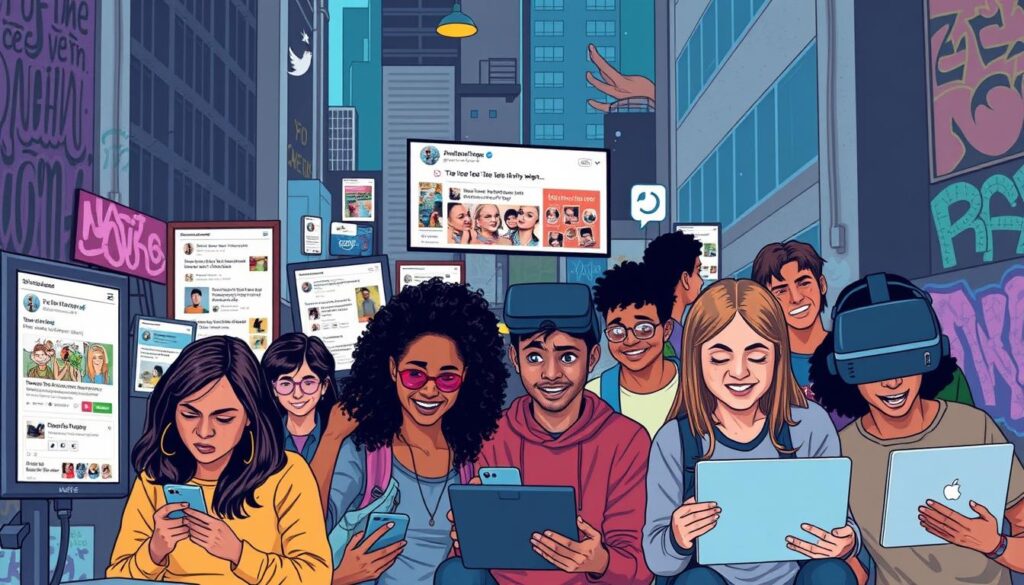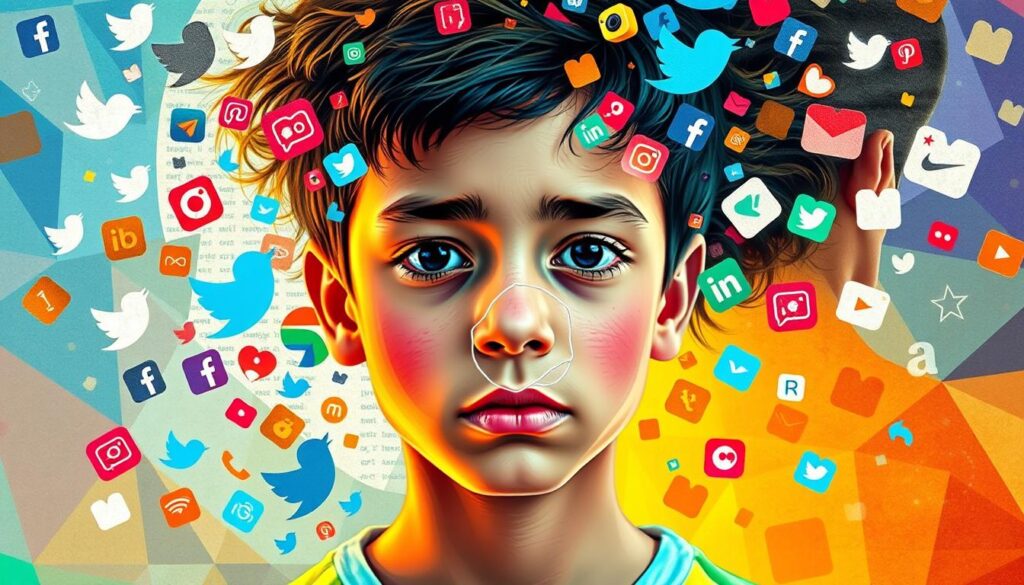In today’s world, youth face many challenges. There are over 1.2 billion young people aged 15 to 24. It’s important to understand their struggles to help them.
Technology, social life, and high expectations make things tough. For example, almost 70% of high school students in rich countries feel very stressed. Also, poor kids are three times more likely to give up on school because of money problems.
Societal pressure can make mental health issues worse for young people. We need to work together to help them overcome these obstacles.
We can create a better world for young people. By finding good solutions and talking openly, we can help them be strong and confident.
Key Takeaways
- The majority of youth today face significant academic pressure, resulting in heightened stress and anxiety.
- Economic challenges such as unemployment rates in various sectors disproportionately affect young individuals.
- Youth from lower-income backgrounds are at a higher risk of dropping out of school, perpetuating cycles of poverty.
- Over 80% of young people express concerns about climate change, highlighting their desire for proactive government action.
- Social media can exacerbate mental health issues, particularly related to body image, among adolescent girls.
- There is a critical need for life skills education, which is often lacking in high school curricula.
- As our society evolves, the skills needed for employment are changing, making it vital for youth to adapt.
Welcome to Therubywadhwa.com
Challenges Faced by Youth !
The Impact of Technology on Youth Challenges

Technology has changed how our youth talk and connect. It brings both good and bad sides. Young people spend a lot of time on screens, over eight hours a day.
This change affects how we talk face-to-face. It might make us lose important skills in talking to each other.
Digital Communication and Social Interaction
Young people use YouTube, Instagram, and Snapchat a lot. 85% of teens watch YouTube, and 72% and 69% use Instagram and Snapchat. These platforms help them connect with others.
But, just watching others can make real talks less. It’s important to talk and share, not just watch.
Cyberbullying and Its Consequences
Technology also brings problems like cyberbullying. About 14.9% of high school students face online bullying. This can hurt their feelings and how they connect with others.
We need parents, teachers, and the community to help. We must make the internet a safer place for everyone.
Screen Time and Mental Health
Too much screen time can hurt a teen’s mind. It can make them feel anxious or sad. Studies show that too much tech use can make teens feel less happy.
We need to understand how tech affects teens’ feelings. This way, we can help them stay happy and healthy.
Social Media: A Double-Edged Sword

Social media is big in youth culture. It helps them connect, express, and grow. But, it also brings challenges that affect their mental health.
Platforms like Instagram and TikTok can push youth to take risks. They might sext or use drugs because of peer pressure. The need to look perfect online can make them feel bad about themselves.
Peer Pressure Amplified by Social Platforms
Peer pressure is now online too. Youth face choices and behaviors influenced by what others do online. A study found 32% of teens think social media is mostly bad.
This can make them feel alone and not good enough. It’s worse for those already dealing with mental health issues. Young people from different backgrounds face even more challenges online.
The Role of Social Media in Mental Health
Research links social media to mental health problems. It can make depression and anxiety worse for vulnerable youth. Platforms can make people feel lonelier and less worthy.
Low-income youth spend more time on social media. This adds to their emotional struggles. It’s key to understand these issues to make online spaces better.
Guidelines for Healthy Social Media Use
We need rules for healthy social media use. Talking about digital citizenship helps youth deal with online issues. Here are some tips:
- Take breaks from social media to reduce stress and bad content.
- Make family rules for device and online behavior.
- Teach critical thinking to spot reliable mental health info.
- Work with mental health experts to talk about social media risks.
Following these steps can help youth have better online experiences. It lets them grow without the harm of online pressures.
Challenges Faced by Youth: Mental Health Issues

Mental health problems affect many teens. They face a world full of challenges. It’s important to know the signs of trouble and talk openly about it.
Prevalence of Anxiety and Depression
Anxiety is a big problem for young people. It affects about 4.4% of 10–14-year-olds and 5.5% of 15–19-year-olds. Depression hits 1.4% of younger teens and 3.5% of older ones.
These issues make school hard and make teens want to be alone. Sadly, suicide is a top cause of death for 15 to 29-year-olds. We must act fast to help.
Identifying Signs of Mental Distress
It’s key to spot mental health problems early. Look for these signs:
- Withdrawal from family and friends
- Changes in eating or sleeping patterns
- Decline in academic performance
- Increased irritability or mood swings
Spotting these signs early can help get the right help fast.
Seeking Help and Support
It’s vital to encourage teens to get help for their mental health. The 988 Suicide and Crisis Lifeline offers 24/7 support. Having friends and adults to talk to helps a lot.
Creating a safe space to talk about mental health helps teens feel okay to ask for help.
Substance Abuse: A Growing Concern
Teen substance abuse is a big problem in our country. It affects many young people. Looking at drug and alcohol stats shows us how serious this issue is.
Statistics on Teen Drug and Alcohol Use
Adolescent substance abuse is a serious issue. For example, visits to the emergency room for marijuana and hashish went up by 50% from 1993 to 1994. In the same time, drug-related visits increased by 17%. Sadly, 91 young people died from drug abuse in 1993.
Alcohol is also a big problem. In 1995, over 2,000 young people died in car crashes because of alcohol. Many young people do bad things because they need drugs. For example, 36% have sold drugs and 24% have committed serious crimes to get them.
The Risk of Overdoses and Illicit Substances
Fake drugs, especially those with fentanyl, are becoming more dangerous. This is causing more overdose deaths in teens. It’s important for parents and young people to understand the dangers of drugs.
Conversations on Staying Drug-Free
Talking openly about staying drug-free is key to preventing problems. Parents should talk about making good choices and the dangers of addiction. This helps young people make smart decisions about their health.
Academic Pressures and Their Effects
In today’s schools, kids face a lot of pressure. This pressure affects their health and happiness. It comes from many places, like parents, schoolwork, and their own goals. Finding a good balance is key.
High Expectations and Performance Anxiety
Parents and teachers often expect a lot from kids. This makes many students very stressed. They worry about doing well on tests and homework.
Those who struggle with organization and time feel it even more. The need to do well can make them anxious. This can lead to bad habits.
Finding a Balance Between Study and Relaxation
Finding a balance is important for kids’ well-being. They can study better in groups and in good places. Taking care of their health helps too.
By focusing on being a good person, not just getting good grades, we help. This makes school better for everyone. It helps kids feel less stressed and learn better.
| Signs of Excessive Academic Pressure | Effects | Coping Strategies |
|---|---|---|
| Extreme competitiveness | Physical health issues | Forming study groups |
| Obsession with grades | Mental health problems | Working in conducive environments |
| Difficulty sleeping | Increased stress levels | Requesting assignments early |
| Loss of interest in activities | Substance use | Avoiding comparisons with others |
| Changes in appetite | Burnout | Focusing on health maintenance |
Bullying: Traditional and Cyber Forms
Bullying is a big problem for kids today. Bullying statistics show 37.6% of students in Ontario get bullied. Cyberbullying is now more common than old-school bullying. It makes kids very anxious and sad.
We need parents, schools, and communities to work together. This is the best way to stop bullying.
Statistics on Bullying Among Teens
Bullying is very common. In Canada, 14% of kids aged 10 to 17 get cyberbullied. Middle and high school kids face even more bullying online, with almost 50% saying they’ve been bullied online.
Old-school bullying also affects nearly 24.32% of teens. Many of these kids also get cyberbullied.
Strategies for Addressing Bullying
We need to act fast to stop bullying:
- Make schools have strong anti-bullying rules.
- Give kids safe places to talk about bullying.
- Teach kids about the harm of bullying through campaigns.
- Help kids support each other against bullies.
The Role of Parents and Schools
Parents are very important in fighting bullying. They should talk openly with their kids. Schools also have a big role.
They should talk about bullying in big gatherings and teach it in class. Working together, we can make schools safer for everyone.
| Type of Bullying | Victimization Rate (%) |
|---|---|
| Traditional Bullying | 24.32 |
| Cyberbullying | 11.10 |
| Both Forms | ~33.0 |
Teen Sexual Health: Education and Risks
It’s key to know about teen sexual health to help them stay healthy. Recent stats show a big worry, as many teens start adult relationships early. About 55% of US high school students have sex by 18, but only 9% use both condoms and birth control.
Learning about safe sex is very important to lower these risks.
Statistics on Teenage Sexual Activity
STIs are a big worry among teens. People aged 15-24 get a lot of chlamydia, showing we need to teach them more. The average age for first sex is now 16, making early safe sex education even more crucial.
Understanding Safe Sex Practices
Safe sex is key to staying healthy. Many teens don’t know the dangers of sex, leading to more STIs and unplanned pregnancies. We must teach them about condoms and other birth control to keep them safe.
They need to know how their actions can affect their health.
Resources for Sexual Education
Having the right info on sexual health helps teens make smart choices. Schools, groups, and doctors are key in giving them the facts. Good sex education programs teach them how to handle their sexual health wisely.
Poverty and Economic Challenges
Poverty is a big problem for our youth. In the United States, about 15.5 million kids live in poverty. This hurts their growth and future.
There are big differences based on race and gender. These differences make the problem worse for youth development.
Living Below Poverty Level
Almost 16% of kids in the U.S. live in families that don’t have enough money. This is a big problem for many kids.
Non-White kids are hit harder. The poverty rate is very high for American Indians and Alaska Natives, Blacks, and Hispanics. Families with moms as the main breadwinner also struggle more, with 23% in poverty.
Places like the South have the highest poverty rates. But the Northeast has a lower rate, at 10.3%.
The Impact of Economic Status on Youth Development
Poverty affects kids’ education a lot. Schools in poor areas get less money. This means they can’t offer as much to students.
Over 40% of students go to schools that don’t have enough resources. This makes it hard for them to learn and grow.
Also, kids who grow up poor often stay poor as adults. This makes it hard for them to improve their lives.
We need to work together to help kids. We must support them and give them better chances. The future of our youth depends on it.
Gender Inequality and Youth Issues
Gender inequality in youth is a big problem. It affects how young people grow and what they can do. There are big gaps in education and jobs that make it hard to reach equality.
About 142 million young people are not in school. Girls are often hit the hardest. Cultural rules and poverty make it tough for girls to get an education.
Gender Disparities in Education and Employment
Education and jobs show big differences between boys and girls. Boys usually get to go to school and find jobs easier. This makes it hard for girls to catch up.
Girls finish secondary school less often than boys. This can hurt their future jobs and money. It makes it hard for them to be independent.
| Issue | Boys | Girls |
|---|---|---|
| Out of School | Lower rates of absenteeism | Higher risk of being out of school |
| Economic Participation | Higher employment rates in many regions | Engaged in less formal employment |
| Education Completion | Completion rates of secondary education | 56% to 63% completion |
Underrepresentation in Leadership Roles
Girls and young women are not seen in leadership often. This limits their voices and ideas. It’s important to help girls and young women grow strong.
Programs like UPSHIFT in Somalia teach young people skills and leadership. Helping girls learn and be mentored can change society. It makes sure all youth have a say in big decisions.
The Importance of Youth Empowerment
Empowering youth is key to a better future. It helps them grow and take charge. This way, they can make big changes in their communities.
Promoting Youth Participation in Decision-Making
When youth help make decisions, they are more likely to follow them. Studies show this leads to more acceptance and action. It also helps them grow and feel connected to their community.
Programs and Initiatives for Youth Development
Programs that involve youth are very effective. They meet community needs and dreams. They also show how important it is to listen to and train young people.
Building Leadership Skills in Young People
Teaching young people to lead is crucial. It helps them grow and help their community. By letting them share their ideas, they become true leaders.
Conclusion
Young adults, aged 14 to 24, face many challenges. They deal with cyberbullying and mental health issues. Families, educators, and leaders must work together to help them.
The job market is tough for them too. Many feel they don’t have the right skills. With over 1.2 billion young people worldwide, we must act fast.
We can help by supporting mentorship and youth-led projects. This way, we can help them grow and succeed. Let’s work together for a better future.
FAQ
What are the primary challenges faced by today’s youth?
Today’s youth face many challenges. These include mental health issues, substance abuse, and cyberbullying. They also deal with academic pressure and economic disparities.
How does technology impact youth communication and mental health?
Technology has changed how teens talk to each other. It helps them connect but can also make them anxious. We need to talk about using technology wisely.
What role does social media play in adolescent challenges?
Social media is both good and bad for teens. It can make them feel bad about themselves and lonely. We need to teach them how to use it safely.
How prevalent are mental health issues among young people?
Mental health problems are common among teens. About 20% of them deal with depression. We should talk openly about mental health to help them.
What are the statistics regarding adolescent substance abuse?
Many teens use drugs, with 31.2% of 12th graders admitting to it. There’s also a rise in overdose deaths. We need to talk about making healthy choices.
How do academic pressures affect today’s youth?
School pressures can make teens anxious. It’s important to find a balance between studying and relaxing. We should teach them how to manage their time and take care of themselves.
What are the statistics and strategies regarding bullying?
Bullying is a big problem for teens, with 55% seeing it as a major issue. We need to work together to stop it. This includes involving parents and schools in the fight against bullying.
What is the state of teen sexual health education?
About 30% of high school students are sexually active. We need to talk openly about safe sex. Giving them access to good education can help a lot.
How does poverty affect youth development?
Poverty is a big problem, with 17.6% of teens living below the poverty line. It limits their education and opportunities. We need to support them more and help them get the resources they need.
What are the gender disparities affecting youth?
Boys often have more opportunities than girls. This is unfair. We need to make sure everyone has equal chances to succeed.
Why is youth empowerment important?
Empowering teens is key to a better future. By letting them make decisions and giving them chances to grow, we help them become leaders. This way, they can make a positive difference in the world.